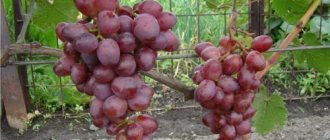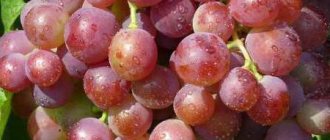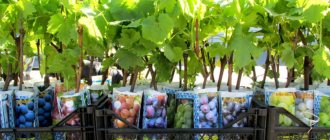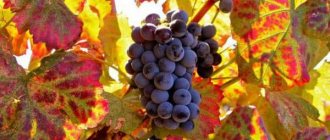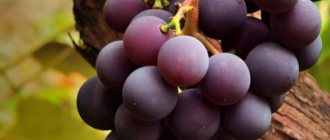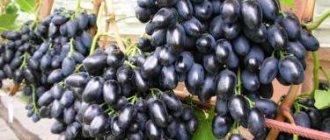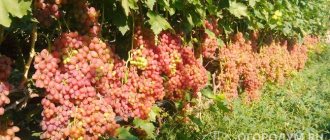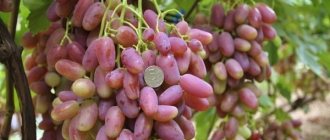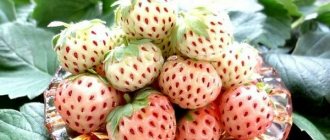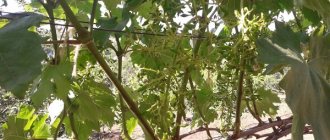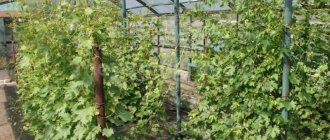Muscat Blau (Garnier 83/2)
Bred in Switzerland and is a highly frost-resistant variety that can withstand temperatures down to -29°C. But it is not planted in the northern regions because it needs a lot of sun and warmth. This grape is suitable only for southern climates.
In terms of ripening, it is medium late (135-140 days), harvesting is carried out in September. His bushes are tall. The clusters are large (up to 300 g) and loose. Berries up to 5 g, round, black. There are bones inside. The vine is sensitive to stress, so it needs regular pruning.
The grapes are undemanding to soil and location. It has good immunity to diseases of fungal origin, but still requires preventive spraying. Wasps, which like the sweet pulp of grapes, cause great damage to the crop. Experts recommend protecting the bunches with special nets.
Muscat Blau is a versatile variety from which wine is made, but also consumed fresh. This variety produces red Muscat wines with a strong aroma.
The yield indicator is average. It can be increased by mineral and organic fertilizing and watering. Be sure to regularly water the grapes during hot and dry periods.
Diseases and pests
Muscat grape varieties are characterized by an increased level of resistance to fungal infections. However, it is better not to take risks and systematically spray with special preparations for preventive purposes.
Note! Harm to the crop can be caused by wasps, which are attracted to the sweet berries. To cope with insects, you should wrap the bunches with special nets, which can be purchased at any gardening store.
When a grapevine is damaged, it is important to determine the type of disease or pest. Next, study the information on control measures and purchase the necessary drugs in the store.
The abundance of muscat grape varieties allows every gardener to choose a plant that will ideally meet his expectations. By properly caring for seedlings, you can grow healthy bushes that will delight you with a hefty harvest.
Muscat pink (Muscat red, Muscat rouge de Frontignan)
It is considered a variety of white Muscat. His exact homeland is not known for certain. Some believe that it is of European origin and was developed in the southwestern part of Europe. Other experts attribute it to Middle Eastern origin - they believe that it grew on the Arabian Peninsula, the territory of Syria and Egypt.
Now Pink Muscat grows in the CIS countries - Tajikistan, Russia, Ukraine, Uzbekistan, Armenia, Azerbaijan and Kazakhstan, as well as in European countries - Italy, France.
Description:
- Its bushes are medium-sized, slow-growing with reddish shoots and green foliage. All shoots are slightly pubescent. One-year-old mature shoots are yellow-brown in color, darker at the nodes. The shoots ripen well or satisfactorily. The number of infertile ones is 10-25% depending on the region of cultivation.
- The leaves are large, five-lobed, the edges are raised upward. The lower part of the leaf blade is covered with bristles.
- The grape bunches are medium in size (up to 204 g), their shape is cylindrical or cylindrical-conical, dense. The grapes are also medium-sized, have a round shape and dark pink color, covered with a strong coating.
- Ripe berries become almost black in color. There are 2-4 seeds inside. The ovaries are prone to shedding. The skin is strong and thin. The pulp is juicy with a strong musky aroma.
To fully ripen the bunches, the grapes require a temperature of at least +29°C. The concentration of sugars in the pulp depends on this. Therefore, in the southern regions of Italy, Portugal, the southern coast of Crimea and Uzbekistan, it is sweeter than in the northern regions - in France, Russia, and the western coast of Crimea.
Fruit maturity occurs after 140 days, the harvest is harvested on the 20th of September. The yield is up to 80 c/ha. The highest yield is recorded on the southern coast of Crimea - in areas with low relief.
The variety is not immune to diseases of fungal origin - downy mildew and oidium, rot, and suffers from attack by phylloxera and grape budworm. In addition, it cannot boast of high frost resistance. At low temperatures it freezes and often suffers from recurrent frosts.
Compared to other varieties, Pink Muscat is less resistant to drought. In rainy weather the berries rot.
This is a universal grape; fine liqueur Muscat and table wines are prepared from it.
Reviews from winegrowers
Despite the fact that many gardeners prefer to cultivate conventional grape varieties, a large number of winegrowers prefer Muscat grapes. Such varieties and hybrids have a very unusual characteristic taste and aroma.
Many gardeners are put off by the prevailing opinion in certain circles that muscats are very demanding and need special attention. In addition, summer nutmegs have very different taste characteristics and can vary greatly depending on the region of growth, as well as weather conditions.
Muscats have a large number of benefits that are so valued by winegrowers. In addition to non-standard taste qualities, such grapes are characterized by stable fruiting and marketable appearance of the berries. Moreover, gardeners have an excellent opportunity to extend the fruiting period of the plant and get a stepchild harvest, which, when ripened, does not help delay the ripening of the grapevine.
Muscat Pleven grape has excellent characteristics , which is similar in origin to the Bulgaria grape and can easily claim the title of one of the most popular and best varieties. “Voitovich’s Gift” has a very similar taste , the berries of which have a very pleasant purple color.
The main characteristics of various varieties and hybrids of muscat grapes and the forms bred on their basis are always very different. The berries can be small or very large, with a significant number of seeds or completely seedless, bright purple or almost transparent in the sun.
Pleven nutmeg
An early ripening table variety of Bulgarian origin, ripening period 115 days. It feels great in the climate of central Russia. The bush is vigorous (reaches 2 m in height) and takes root easily. The vine can withstand up to 35-45 buds. Fruit shoots are cut to 6-8 buds. The clusters are large - the weight of one reaches up to 600 g, conical, loose, which allows the berries to ripen evenly.
Grapes up to 8 g, green with an amber tint. Under the sun's rays they acquire a bright yellow color. The flesh is sweet and crisp with a faint musky aroma. The crop begins to bear fruit in the 3rd year. Harvesting begins in early August and ends in the third decade of this month.
Ripe fruits attract the attention of wasps and birds, so it is necessary to protect them from uninvited guests.
This is a frost-resistant variety, can withstand temperatures down to -25°C, is undemanding to soil, but is not resistant to diseases of fungal origin. The yield is high - 140 c/ha.
Muscat summer
An early ripening variety from Moldavian breeders, ripening period 110-120 days. In the southern regions, harvesting occurs at the beginning of August, in mid-latitudes - at the beginning of September.
The bush is tall, can reach 3 meters. The clusters are cylindrical-conical with medium density, one of the largest in size. The average weight of one bunch is 650 g, but there are specimens weighing 1 kg.
The berries are large - their length reaches 28 mm and width up to 22 mm. The grapes are medium in weight - up to 8 g. They have an oval-elongated shape and are colored amber-white. In the sun they turn golden amber. The crop is resistant to downy mildew and moderately resistant to powdery mildew.
This is a medium frost-resistant variety that can withstand cold temperatures down to -23°C, but requires shelter. The load on the bush is 30-40 buds; fruit vines are pruned to 6-8 buds. The number of fruit vines reaches up to 80%, they ripen well. Cuttings take root easily.
Experts recommend cultivating summer muscat on the sunny side, which has a beneficial effect on yield and taste - the grapes will be sweeter.
Features of cultivation
Early pink Muscat grapes, compared to other varieties, are less resistant to drought. But it is not as sensitive to soil waterlogging as white nutmeg. Shoots are sensitive to low temperatures. In steppe regions and foothills, they often suffer from late frosts in spring. Early autumn frost also harms the grapes of this variety.
Grapes are planted in the soil from mid-April to early May, or at the end of September, beginning of October. Fertile soil is poured into the planting hole, after mixing it with mineral fertilizer and manure. The cutting is inserted into a small mound made in the center of the hole. Cover it with soil to the point where growth begins. After that, the pink nutmeg seedling is watered with water and covered with a jar or cut plastic bottle.
Muscat Donskoy
An ancient technical variety that is used for making dry and dessert wines. This early ripening grape ripens in 115 days, making it suitable for cultivation in regions with short summers. Ripe clusters are harvested in mid-August.
The bushes are tall. The leaves are medium sized, three-lobed. The upper part of the leaf blade is matte and wrinkled, the lower part is covered with small bristles.
The clusters are medium - the weight of each does not exceed 200 g, cylindrical-conical in shape and medium density. The berries are small (up to 2 g), round, blue-black. The pulp is juicy with a strong nutmeg flavor. The productivity indicator is high. The crop begins to bear fruit after 2 years and grows on any type of soil.
The berries do not fall off, can remain on the branches for a long time, and do not crack.
The variety is susceptible to attack by phylloxera, with average immunity to diseases, so preventive treatment with drugs is necessary 1-2 times a year.
A distinctive feature of the variety is the large number of inflorescences on the shoots - to make the berries larger, the inflorescences are thinned out.
The variety can withstand low temperatures down to -30°C. The shoots ripen well. The number of fruiting vines on a bush is 50%.
Landing rules
Regions with a warm climate and average humidity levels are suitable for mass cultivation. Experts believe that the variety is not suitable for small farms. The crop requires careful care, and the berries are best used for making expensive wines.
However, if an amateur gardener decides to pamper himself with exclusive grapes, no one has the right to prohibit him. It is worth considering that early nutmeg does not like loamy, clayey soils, or soils with high acidity. If not properly cared for or in the wrong place, the yield will be weak and the berries will have poor taste.
How to choose quality seedlings when purchasing
Externally, seedlings of different varieties are no different. The type of crop can be determined 2-3 years after planting, when the first berries appear. Therefore, you should buy seedlings from trusted sellers. The cost of one scoop of extra-early white nutmeg is about $5. If the purchase is made on the market, you need to know several rules for a successful purchase.
- It is better to buy the vine immediately before planting it in the ground in a permanent place.
- The optimal age for a baby is 1 year. Two-year-old seedlings are poorly accepted, and an adult plant will dry out completely from the first days.
- The height of a one-year-old vine should be 55 cm, the thickness of the stem should be about 0.5 cm. The vine should have 2 shoots.
- The color of the seedling is brown. You cannot buy yellow or green shoots. The bark should be uniform, smooth, without spots or damage.
- A healthy trunk has at least 4 healthy buds.
- The root system must be well developed. Processes – at least three 15 mm each.
- A healthy grapevine does not break when bent.
Currently reading: What is the difference between Isabella grapes and how they are used
A conscientious seller either demonstrates the freshness of the seedling himself or gives buyers the opportunity to check.
Where to plant on the site
The southern plant needs sun. Moderate humidity, good ventilation. A place for planting a vineyard should be chosen that is sunny and protected from the wind. The depth of groundwater flow is 4-5 m from the surface.
For full growth of the crop, seedlings are planted in black soil, on rocky, loamy soils. Experienced winegrowers add gravel to the soil when planting. This provides good ventilation to the root system and prevents moisture stagnation. The best place is a hill, a hill.
How to plant
It is recommended to plant seedlings in the middle or end of May. Preparation of planting material begins in April. Soaked in growth stimulants. Autumn planting is allowed, but then the harvest will have to wait a year longer.
If there is more than one vine, they are planted in rows. The row spacing is 2-3 m. The soil is well watered, black soil and fertilizer are added. Potassium supplements are recommended. The seedling is placed in a hole, the roots are straightened, covered with earth, watered, and mulched. Sawdust, straw, grass, and earth are used as mulch.
The pit should be 1 m deep. A drainage layer of stone, crushed stone, and gravel is laid on the bottom. The earth is mixed with humus, black soil, sand, fertilizers, and the hole is filled halfway. The rest of the soil is sprinkled on the seedling after planting. It is recommended to install spikes near the vine and stretch ropes so that you can see where the grapes begin to grow.
Extra early red nutmeg
Moldavian table variety. The eloquent name indicates that it ripens quickly, within 95-100 days. The variety is suitable for growing in the middle zone. If the temperature does not rise above +20°C, then the ripening period increases. In the southern regions, the harvest is harvested in mid-July, in cooler regions - in mid-August.
The bushes are strong or medium-sized. The leaves are small and rounded. The outer part has a wavy surface. The clusters are large - weighing from 300 to 600 g, conical, loose. The berries are medium in size, their weight does not exceed 5 g. However, the older the bush, the larger the berries and clusters become.
The shape of the grapes is round or slightly oval, red. Ripe berries acquire a purple color. A whitish waxy coating forms on the surface. The pulp is fleshy, crispy with a seed inside and a pleasant mild taste.
This variety is resistant to gray mold and has moderate resistance to downy mildew and powdery mildew. The grapes tolerate transportation well. It has average frost resistance, can withstand cold temperatures down to -23°C, and requires shelter. There is not much sugar in the pulp, so wasps are not interested in it.
Productivity is average. The load on the bush is 35-40 buds, pruning of fruit shoots is carried out by 6-8 buds. The vine and shoots ripen well, ripened shoots acquire a bright brown tint. There are 65% of fruitful shoots on the bush.
Benefits and harms
In addition to the fact that the berries contain a lot of sugars, for example, fructose and glucose, they also contain many antioxidants (almost as much as green tea), which is undoubtedly considered an advantage.
Grapes are also rich in potassium, iodine, magnesium and iron. Because of this, it is indicated for people who suffer from diseases of the cardiovascular system, as well as hypertension and anemia.
The berries are characterized by a diuretic effect. They prevent the formation of stones. But (in comparison with pharmaceutical drugs) grapes do not reduce the amount of potassium in the human body, since they contain a lot of it. Magnesium allows you to get rid of harmful sodium salts, facilitating the functioning of the kidneys.
Despite the fact that the benefits of eating fresh grapes are simply incredible, they can also cause harm. For example, despite the real benefits, people with metabolic disorders are strictly prohibited from eating it uncontrollably and in huge quantities (kilograms in one sitting).
Sometimes this product should be consumed cautiously or completely eliminated from your diet.
- This product may be harmful if you are hypersensitive.
- Unripe grapes contain a lot of tannin, which can cause gastrointestinal obstruction.
- The combination of grapes with dairy products, whole milk or cool water is especially dangerous. In rare cases, individual intolerance also occurs.
- Overuse may result in diarrhea, bloating or constipation.
This material will tell you about grape seed oil for the face.
Children under three years of age should not be given fresh grapes to avoid unpleasant consequences. It contains tannin and organic acids - substances that are not beneficial for children.
Tannin reacts with the baby’s gastric juice that begins to secrete and gradually turns the food that is currently contained in the stomach into a viscous sticky lump that cannot leave the baby’s body on its own.
For people with intestinal diseases, especially in the postoperative period, fresh grapes are contraindicated due to the high content of tannin and glucose.
Obese people should not eat grapes too often. It is also contraindicated for those who have recently undergone surgery on the abdominal organs.
You can often see a waxy coating on the grapes, which cannot but confuse any buyer. However, it has nothing to do with the treatment of fruits with chemicals. This is a natural defense.
Muscat Livadia (Pavel Golodriga 5)
An early ripening variety from Ukrainian breeders, which is ideal for beginners and belongs to the table species. The bushes are medium-sized, the vine ripens well. The bunch is loose, branched and large. On average it weighs 500 g, maximum weight is 800 g.
The berries are medium in size, yellow-green in color and elongated in shape, similar to an egg. When ripe they acquire a beautiful golden hue. There are 1-3 small seeds inside the berries. This is a medium-resistant variety in terms of frost resistance, can withstand temperatures down to -21°C, and does not suffer from drought.
The advantage of grapes is excellent immunity to fungal and infectious diseases, as well as phylloxera.
Productivity is high. If the air temperature in summer averages +25°C, then ripe bunches are harvested in the second half of July. The taste of the berries and the amount of harvest are influenced by weather conditions. With a lack of sun and heat, the grapes become sour and the yield drops.
The optimal load on the bush is up to 35 buds when cutting shoots into 4-6 buds. Shoots with a good degree of ripening.
Growing
A period of relative rest begins in the second half of autumn (after leaf fall). And ends at the beginning of the growing season. At this time, the processes of respiration and evaporation, transformation and movement of organic substances occur very weakly. It is called a period of relative rest. From the beginning of leaf fall to the end of January - beginning of February, a period of deep dormancy occurs, then a period of forced dormancy begins, the plants are physiologically prepared for the growing season, climatic conditions are not yet favorable for this.
For this variety, the period of relative dormancy in a temperate climate lasts 4 months - from November to March, but depending on the climatic conditions of the area, it can be shorter or longer.
Planting period
Seedlings (cuttings) are planted in open ground in late March - early April. Protection from night temperature drops in the form of a film shelter is required. You can start planting cuttings at the end of autumn, when the plants enter a dormant state. The cuttings are stored in a dark, cool place, wrapped in damp cloth and plastic wrap. At the end of February they are taken out into the light, into a warm room.
Related article: Mizar - grapes
Ripening period
The grapes ripen in mid-September. For longer preservation of pink Muscat grapes, it is recommended to remove the bunches with pieces of vine up to 10 centimeters. Collection should be started in dry, cloudy weather. Do not touch the berries with your hands under any circumstances, so as not to disturb the natural coating of wax. Boxes or drawers should be lined with paper. Place the bunches with the ridges facing up. Boxes of products should be stored in a dry cellar or basement at a temperature of 6 - 8 degrees.
It is very important to correctly tie young shoots to the trellis wire. The correct garter will allow you to evenly distribute the fruiting branches on the trellis . For tying, use a material that will not leave marks or constrictions on young branches.
Read about grape garter here.
Plants of this variety should not be over-fed with nitrogen fertilizers.
Disease Prevention
In June, when the length of the shoots reaches 30 centimeters and five leaves are formed, spraying with chemicals against diseases such as mildew, oidium and spotting should be carried out.
All blackened vines damaged by frost are cut down almost to the soil level, leaving 6 - 8 cm above the surface.
The cut areas are carefully protected with a garden knife, smeared with varnish, covered with soil or covered with clay.
This variety, like Ruslan grapes, is resistant to some fungal and infectious diseases. This is one of the best non-covering varieties. Plants prefer chernozem soils or sandy loams, but bear fruit well in other types of soils; in general, this variety is unpretentious.
Trimming
When cultivating pink Muscat and the Veles variety, short spring pruning is recommended; 2 to 3 inflorescences should be left on one shoot.
It is very important to normalize the load of bushes. When the length of the shoots reaches 15 cm and the first inflorescences appear, it is necessary to make the first green breakout. All double shoots that have grown from one eye should be removed. Underdeveloped, painful and damaged branches are cut out. Optimal pruning of vines to 8 - 10 buds.
Two weeks after the first cutting, a second cutting is carried out, thereby once again reducing the load on the bush.
First of all, you should remove all the fattening shoots of this year and get rid of the root shoots. These procedures must be started as early as possible so that the shoots and fattening shoots do not take on the nutrients that are so necessary for the full ripening of the berries.
To quickly form new sleeves, it is recommended to vaccinate or leave four shoots.
This variety is always unrivaled due to its beauty and size of the berries. The taste of the berries is harmonious, the pulp is fleshy, the skin is not felt when eating. The berries are not damaged during storage and do not crack after heavy rains.
Muscat novoshakhtinsky
A hybrid from Russian breeders with an early ripening period (110-115 days), it belongs to the table form. The bushes are tall. The clusters are large - on average they weigh 500 g.
The berries are also large in size, weighing up to 10 g. They have a round shape, their color can vary from purple-red to cherry. The pulp is juicy, crispy with 2-3 seeds and a nutmeg-caramel taste.
The peel is very thin, but it does not crack. The harvest is stored on the bushes for a long time, while their appearance and taste do not deteriorate. This is a frost-resistant hybrid, not afraid of cold temperatures down to -24°C, and tolerates transportation over long distances. It has average resistance to diseases and pests and is often affected by black rot. The yield is high, but the berries ripen unevenly.
Features of Muscat grapes
Muscat grapes began their journey from the fertile lands of Syria, Egypt, Rome and Greece several thousand years ago. The first written evidence dates back to the 8th-6th centuries BC. – Homer and Hesiod mentioned wines that tasted like honey. In those days, they did not know how to prepare alcohol, and the strength of the wine depended on the sugar content in the grapes themselves. Therefore, the unusually sweet nutmeg was especially valued, but even the vines were additionally twisted, the leaves were torn off, and then the berries were dried in the sun to evaporate excess moisture.
Interesting! Despite their high sugar content, grapes are low in calories and also rich in calcium and potassium.
Since 1828, muscats began to be grown on the lands of the Crimean Peninsula. Later it spread to the southern outskirts of the Russian Empire. At this time, it can be found in the Stavropol and Krasnodar regions of the Russian Federation, Ukraine, Turkmenistan, Moldova, and Dagestan. But the largest plantations are located in Portugal, Spain, Italy and France.
Muscat grape varieties are characterized by a high content of phytoncides, which have a beneficial effect on the natural bacterial balance of the intestines. The berries are large, fleshy with a small number of seeds (2-3 pieces), the peel is translucent and tender. The musky taste and smell of grapes is given by thornoid compounds found in the skin, as well as the adjacent pulp of the fruit.
Russian amber
The variety was bred by Russian scientists, included in the State Register of the Russian Federation, and it is recommended to grow it in the Central Black Earth region. It belongs to the table form and early ripening varieties - the crop ripens in 110-120 days. The bush is medium-sized. The shoots are growing well. The leaves are medium in size, five-lobed, green, sometimes grayish in color. The bunch is about 132 g in size, cylindrical-conical in shape.
The berries are medium-sized, round, greenish-yellow with an amber blush. The pulp is fleshy and juicy with the aroma of forest nutmeg. There are 2-3 bones inside it.
This is a medium-winter-hardy crop, tolerates frosts down to -22°C, and requires shelter in winter. In the southern regions, it is enough to press the vine to the ground. The variety is immune to mildew, but is susceptible to powdery mildew, and in humid climates - gray rot.
The berries are prone to cracking. 2-3 inflorescences develop on the shoot - so that the bushes are not overloaded with the harvest, they need to be trimmed short and excess green shoots removed. Productivity is average.
Features of seasonal care
Care measures for white Muscat are no different from other grape varieties. It is necessary to treat the crop against pests and diseases, apply fertilizer, water during drought, remove weeds, and loosen the soil around the vine. The crop is treated before flowering begins. Use copper sulfate, Bordeaux mixture, Topaz, Fitosporin.
Watering
Extra early white nutmeg does not tolerate waterlogging. In dry summers, an adult bush is watered twice a season. To ensure complete hydration of the root system, the ground around the vine is dug up, a ditch is made around it, and water is poured in. About 60 liters of water are poured under one bush.
Then the ground is leveled and mulched. If the summer is moderately rainy, additional watering is not required. It is recommended to water the bush before flowering to stimulate growth, during the formation of berries, so that they are juicier in the fall.
Young seedlings tolerate drought less well. At first they are watered every day. Gradually reducing soil moisture to once a month.
Top dressing
Grapes tolerate an excess of fertilizers much worse than a lack of them. During the season, an adult plant requires several feedings. At the same time, organic and chemical fertilizers are combined. The first fertilizing is applied in the spring before the leaves begin to bloom. Use a mixture of mineral fertilizers. Superphosphate, Potassium Sulfate, Urea.
Before flowering, apply organic fertilizer - chicken droppings, compost, manure. During the formation of berries, a second feeding is done with mineral preparations, but do not use nitrogenous agents. In the fall, after harvesting, it is recommended to enrich the soil with wood ash or humus. Young seedlings do not need additional feeding during 3 years of growth.
Support, shoot garter
White nutmeg forms wide bushes that need support and garter. Moreover, grapes need winter shelter. Therefore, you need to make a design that meets all these requirements.
Currently reading: Grapes: beneficial properties and delicious varieties
The basis is a stationary vertical support. Twine is pulled between it in 2-3 rows. The first tier is located at a level of 50 cm, 2 - 120 cm, 3 - 2 m. As the vine grows, it is pulled up to the trellis, young branches are directed upward.
Soil care
If the layer of earth around the vine is mulched, you need to periodically check the condition of the mulch. If there is no covering, you should regularly loosen the soil after watering or rain, and remove weeds in a timely manner.
Trimming
Bushes are prone to excessive branching. Leaves without proper care form a thick layer through which the sun's rays cannot penetrate. In this state, the yield drops, the berries crumble and ripen unevenly.
To avoid excessive branching, excess branches are removed in the fall, and pruning is also carried out “on a knot” to form young shoots. In the spring, excess buds are periodically removed, leaving 18 eyes on the bush. Each fruiting shoot should have 3 buds. Throughout the summer, pinching should be carried out, removing leaves and young shoots that do not have grape clusters.
Preparing for winter
In the southern region of the country, grapes tolerate winter well and do not require additional shelter or mulching. In areas with a temperate climate, where winter already arrives in November, a greenhouse for the vineyard or shelter for a separate bush is made for the winter.
The usual mulching of the root system with straw, sawdust, leaves, and pine branches is also suitable. Waterproof material is placed on top. The structure is removed at the end of April, when the temperature reaches above zero.
Hamburg (Muscat black of Alexandria, Muscat de Hamburg)
The variety was bred by English breeders for cultivation in greenhouses. This heat-loving crop grows only in the southern regions of France, as well as in Spain, Greece, Tunisia, California and Crimea. It is a medium-sized bush with creeping shoots and a lot of foliage. The plant requires regular pruning. Read about spring pruning of grapes here.
A mature vine changes its green color to red-brown. The leaves are five-lobed with a reddish border and shaped like hearts. There is pubescence on all sides of the leaf blade, but in the lower part it is more abundant. The bunch is conical - up to 20 cm in length. Its weight is 170-260 g.
The berries are round or oval in shape, the weight of one berry is no more than 4 g. It contains 2-3 large seeds. The pulp is juicy and fleshy. The skin is hard, black with a waxy coating.
Varietal features:
- In terms of ripening time, it belongs to the medium-late varieties (148 days). The harvest ripens in the second half of September. Berries can be stored for about 3 months without losing their taste and presentation. They are transportable. However, the berries are prone to shedding and peas.
- In terms of frost resistance, the crop has very low indicators - at -19°C, 50% of its eyes freeze out, so it requires shelter for the winter. Grapes are not immune to mildew, gray rot, oidium, or bacterial canker. Of the pests, it is often annoyed by phylloxera (aphids), which settle in the root system of the plant.
- Yield indicators are unstable and depend on many factors. In favorable years, up to 120 centners can be collected from 1 hectare. The load on the bush is 18-20 shoots, of which up to 17 are fruitful. Due to low frost resistance, pruning is carried out with 4-6 eyes.
More often, grapes are used as table grapes and eaten fresh. Some winemakers use it to make wine.
The best Muscat grape varieties
Previously, muscat grapes were grown only in warm regions because they were not resistant to cold and fungi. Now there are hybrids adapted to different climatic conditions. There are also grape varieties for the middle zone. Breeders were able to develop berries with a higher sugar content, more developed immunity and high yield, which allows you to choose a variety to suit your needs.
Pink
Pink muscat grapes were developed 200 years ago. The shoots have a red tint, but turn yellow by the time of harvest, the leaves are large, round, the shape of the cluster is cylindrical, its weight is 120-200 g, the flowers are bisexual.
Pink nutmeg ripens in 4.5 months. As the juices accumulate, the berries darken from soft purple with a slight white coating to dark purple, almost black. They are round and large in shape. Sugar content is 25-35%. The vine has an average growth rate and does not need regular pruning.
The variety is not picky about soil composition and can tolerate frosts down to -25 degrees Celsius in winter. To ripen, it needs warm, dry weather; watering should not exceed 4-5 times, that is, in fact, there will be enough rain. But if the summer season turns out to be rich in precipitation, the grapes may rot.
The immunity of pink nutmeg is quite weak, it is susceptible to oidium, phylloxera, mildew, spider mites, leaf rollers, and phylloxera.
Summer
It is a fast-growing shrub with powerful shoots and large elongated clusters. The weight of the latter can reach 700 g.
The berries are light green with an amber tint and a white coating (the brightness of the color depends on the degree of illumination of the vine). Their shape is elongated oval and slightly pointed at the end. Sugar content can reach 20%.
The variety has excellent performance for cultivation in central Russia. It is able to withstand frosts down to -27 degrees Celsius (when covered), sudden changes in climatic conditions, ripens quickly, has very high yields, and is not susceptible to fungi and mildew. Diseases that are dangerous to it are chlorosis and bacterial cancer; occasionally it can be spoiled by oidium or root phylloxera.
Important!
The summer variety tolerates transportation well, but once picked from the vine it does not last long.
Super red
The Moldavian variety Superred has a unique combination of qualities. It is an extremely early grape with an average yield, ripens in 3-3.5 months, so harvesting can begin as early as July, it is frost-resistant, and in addition, it has excellent commercial properties:
- calmly experiences transportation;
- stored without losing taste for up to 12 weeks;
- The sugar content is no more than 20%, so the berries do not attract wasps, do not overripe, and do not rot for a long time.
Based on the name, it is clear that the grapes are red in color, but gradually acquire a purple tint. They are large round in shape, forming cylindrical clusters weighing up to 400 g. The shoots are also red, the leaves are bright green, abundantly covering the vine. The relatively low sugar content makes this Muscat an optimal option for making table wines.
Super-red grapes are completely not susceptible to gray rot; mildew and oidium pose a slight danger. Good immunity and the ability to ripen quickly protect the berries from most fungi and diseases.
Novoshakhtinsky
Muscat is an early ripening (harvesting begins in the first ten days of August) and high-yielding varieties. The flowers are self-pollinating, almost 100% of the ovaries ripen, and one bunch can weigh up to 600 g. The berries are large, purple with a red tint and a faint white bloom, have 1-3 seeds, the peel is thin. Sugar content reaches 30%.
Novoshakhtinsky grapes are resistant to frost, can easily withstand transportation, are stored for a long time, and have average resistance to mildew and oidium, and the diseases usually affect the leaves, not the fruits. A characteristic feature of the variety is its adaptability to unstable weather conditions; it can easily tolerate rainy summers.
Russian
It belongs to the early ripening muscats, ripens in 3-3.5 months, so the harvest is already in July. Its main advantage is its strong immunity, which protects the fruit from all diseases.
Interesting!
The Russian variety has a taste that is characterized by a combination of sweetness and sourness that is unusual for other musky grapes.
The berries are large, round, with a white coating, red-orange, pink or purple, depending on the degree of ripening. They form large conical clusters weighing up to 600 g, which allows you to collect high yields from one bush - 20-25 kg.
Livadia
The Livadia variety is the best option for starting grape cultivation. It is heat-loving, like most nutmegs, but can withstand frosts down to -20 degrees Celsius. He is also not afraid of drought. Strong immunity protects Livadia from infections and fungi that affect other vines. And thanks to the dense skin, wasps cannot bite through the fruits.
The bushes are not tall, do not need pruning, there is not a lot of foliage, the flowers are bisexual, and do not need additional pollination. Livadia grapes prefer loams or sandstones, but feel good on other soils.
The maximum sugar content is only 19%, but it may be less if the berries have had little sunlight in the summer.
The yield of Livadia is high: one bunch weighs from 500 g to 800 g and has an elongated cone-shaped shape. The grapes are not large, oval, light green in color with an amber tint and a barely noticeable white coating.
Donskoy
The variety has many strengths and weaknesses. The first include a sugar content of 30% and high yield. Donskoy grows well on any soil, is frost-resistant - can withstand up to -30 degrees Celsius.
But with a large number of ovaries, only 50% ripen, and the berries are very small. To increase their size, you need to thin out the brushes. The color of the grapes is dark purple with a slight white coating, the shape is round. Immunity is average; for Donskoy, the greatest danger is phylloxera.
Pleven
The Bulgarian variety Pleven ripens in 4 months. The yield is higher than that of previous grapes and amounts to 80-85%, and the weight of one bunch can reach up to 600 g. The berries are large, oval, amber in color with a green tint and contain 20% sugar.
For Russia, Pleven is useful for its frost resistance; it can easily withstand temperatures of -25 degrees Celsius. In addition, the variety has good immunity and is practically immune to fungal infections.
Important!
To increase the size of the grapes, organic fertilizers should be applied frequently.
Blau
The Blau variety was developed in Switzerland. The resulting grapes can survive frosts down to -30 degrees Celsius and ripen in 3.5-4 months. It is quite resistant to diseases and fungi, but it is still recommended to carry out preventive spraying with phytoncides before fruit set.
The clusters are small, their weight is no more than 300 g, the berries are round, medium-sized, and purple in color. The grape yield is high, but to improve quality the vines should be pruned. The composition of the soil and the amount of sunlight do not matter for Blau, however, it needs fertilizers and abundant watering.
The main disadvantage of the variety is its thin skin, which makes the fruit an easy target for wasps. To protect the berries, the bushes should be covered with fine-grained mesh, and insect traps should be placed nearby.
White
This is one of the elite oldest varieties of Muscat. It needs loamy, well-drained soil. A rocky, open, south-facing slope is ideal. He prefers potassium fertilizers.
Important!
To increase the ovary, it is recommended to carry out additional pollination of flowers.
The white grape variety is characterized by early ripening and average yield; it is harvested in the third ten days of September, when the sugar content reaches its maximum value. On average, its indicator should be 30% of the weight of the berry.
The weight of one bunch can be 450 g, but usually ranges from 110-120 g. The ripening period is 4-5 months. The vine grows quickly, so it needs to be pruned.
White nutmeg is difficult to care for; it is very heat-loving, unable to survive even short-term droughts, pest invasions and fungi.
Buffet
Muscat Furchette ripens in 4 months, has excellent yield, one bunch can reach 800 g. The berries are dark purple, large, oval, with a bluish bloom. The variety is stored for a long time, tolerates transportation well, and can withstand temperature drops down to -23 degrees Celsius.
Fourchette grapes are moderately resistant to fungi; in order to protect the crop, it is recommended to carry out two sprayings, one before flowering and the other after it. Gray rot and wasps are not dangerous for this nutmeg.
Long awaited
The variety is an early ripening variety; it ripens in 3.5 months. The clusters are large, cone-shaped, weight can reach 1,500 g. The grapes are elongated, oval, light green in color with an amber tint; when unripe, they are white. Their characteristic feature is that some of the berries have seeds, while others are missing. Flowers are bisexual, self-pollinating.
The long-awaited plant is frost-resistant, but to preserve the vine, it needs to be covered for the winter. Resistance to fungi and diseases is high; it is recommended to carry out one spraying with phytoncides before flowering.
The variety is well stored and lends itself well to cuttings. For planting, it is better to choose a sunny place and add organic fertilizers to the hole.
Amursky
Amur grapes belong to the old Muscats of Asian origin. According to legend, it was discovered near the Amur River, and the name of the berries came from it. A distinctive feature of the variety is its rapid shoot formation.
Attention!
The Amur variety must be regularly pruned, otherwise the grapes will acquire purely decorative functions, since all the plant’s forces will be spent on maintaining the vine, and not on growing fruit.
Otherwise, this nutmeg is unpretentious, develops quickly, and produces high yields. The main advantage of the variety is its unique frost resistance; it is able to survive temperatures of -40 degrees Celsius.
Amur blooms in May, and harvesting occurs in September. By this time, the bark and leaves turn red, and the berries darken from orange-red to dark purple with a bluish bloom. The weight of one bunch can be 250-300 g.
The weak point of grapes is their low resistance to diseases, so they must be regularly sprayed with products against fungi, cancer and gray rot.
Hamburg
The Hamburg variety was bred in England, it is medium late, it takes about 5 months to ripen. The harvest begins in the second ten days of September; theoretically, muscat can produce large volumes of fruit, but sometimes they turn out to be much less than what the winegrowers expected.
It is demanding on climatic conditions, needs warmth and sun, does not tolerate frost well, so the bushes should be tightly covered for the winter.
The immune system is weak, grapes often suffer from gray rot, oidium, mildew and phylloxera.
Otherwise, this variety is also called Black Muscat, since its berries have a thick dark purple, almost black color. They contain 2-3 bones. The clusters are conical, loose, small, their weight barely reaches 260 g, while the grapes themselves are large, round with hard skin.
The strengths of Hamburg Muscat include excellent transportability and the ability to be stored for about 3 months.
Noble
A good example of a strong hybrid variety. Noble produces high yields, one bunch weighs on average 600 g. It is conical in shape, loose, the berries are very large (3-4 cm in length), light green, yellow when exposed to light, translucent. The grapes ripen in 3.5-4 months.
Interesting!
The color of Noble depends on the amount of sunlight; the more sunlight hits the vine, the more intense the honey color the berries acquire.
Frost resistance is average, it can withstand temperatures of -23 degrees Celsius, but it is better to cover the bushes for the winter. Immunity is mediocre, it is recommended to carry out several sprayings per season.
Among the undoubted advantages for winegrowers are the ability of the variety to survive long-term transportation, as well as the indifference of wasps to it.
Moscow
This is an early grape, its ripening period is slightly less than 4 months. It is distinguished by its high frost resistance - it can withstand up to -30 degrees Celsius. In fact, Moskovsky is a hybrid of the Amur variety, it was bred in Russia and has taken root well in the dachas of amateur winegrowers.
The bush grows quickly, there is not a lot of green mass, the clusters are small, of various shapes, the berries are light green, small with 4-5 seeds inside. But the taste is sweet with a slight sourness. The sugar content is 17-17.5%. The weight of one brush on average reaches 250 g, but can reach up to 470 g.
The immune system is not able to protect the plant, so it needs to be sprayed. The soil for Moscow grapes requires loose and acidic soil; it is better to plant it on the southern sunny side.
Muscat amber
Moldavian early ripening variety (105-117 days). This allows it to be grown in areas with short but warm summers. In the southern part of Russia, mature clusters are harvested in the second half of August. The culture prefers warm slopes with fertile, easily permeable soils.
The bushes are medium-sized. The clusters are cylindrical, medium density with amber berries. The leaves are small. There are no veins on the bottom of the leaf. They are round in shape and do not diverge into large blades. Bubbling is observed on the upper part of the leaf plate, which is why the leaf has a convex shape. The bunch is no more than 17 cm in length, weighing up to 340 g.
The berries are usually round, rarely oval. It contains 2-3 seeds. The skin is dense, yellow-green in color, and on the sunny side it takes on a golden hue. The pulp is fleshy, tender and crispy with a specific nutmeg aftertaste. This is a table variety.
When stored, grapes retain their taste and marketable appearance for up to 3 months.
The berries are not prone to cracking and rotting, but the plant is damaged by fungal diseases - downy mildew and powdery mildew. The variety can withstand frosts down to -18…-20°C. Productivity is high - 120 c/ha or more. When pruning, 6-7 eyes are left on the fruiting vine.
conclusions
- Muscat refers to a group of muscat varieties (Rusbol, Rossoshansky, Natukhaevsky, Golodrich, Kishmish, Muskateller/Muskatel, Vostorg, Muscari/Muscaris, Citronny, Solomka, Raspberry), which are distinguished by one common feature: the characteristic taste and smell of muscat.
- In general, nutmeg varieties are very heat-loving and have little resistance to fungal diseases. But thanks to the work of breeders, varieties have been developed that are both frost-resistant (winter and summer) for Siberia, and insensitive to diseases.
- According to the description, any muscat grapes have high taste characteristics: according to the tasting scale, their quality is rated from 7.5 to 9.5 out of 10 possible.
- Most varieties are distinguished by excellent yield, large beautiful berries and a very marketable appearance of the bunches (Hungarian, Odessa, Kuban, Besedochny, Dniester, Shakhty).
- The pulp of the berries is juicy, but fleshy and dense. The grapes tolerate transportation well and are perfectly stored without losing their taste.
- Table muscat grapes are traditionally grown more often on private farms for their excellent taste. Technical varieties represent first-class raw materials for the production of the highest quality wines and sparkling wines.
Read about how to preserve grapes in this article.
Far Eastern Muscat
A variety from Primorye breeders with a very early ripening period, related to the table form. It is distinguished by the small size of the bunch, the mass of which does not exceed 80 g. It is conical in shape, less often - branched.
The berries are also small, up to 1.9 g, round, slightly flattened, yellowish-white in color with a pleasant taste. The leaves are medium-sized, less often large. There is no pubescence on the lower part.
The advantage of the variety is excellent winter hardiness - the plant tolerates frosts down to -30°C, and average resistance to diseases and insects. The yield is average.
Characteristics of the bush
In spring, the soil under the bushes can be covered with a transparent film. When it gets hot, the film is removed.
You can dig large stones in the vineyard, which will accumulate heat during the day and release it to the bushes at night.
Use these little tricks, which will lead to an increase in the sum of active temperatures (SAT) by 500 degrees or more during the growing season.
After the onset of frosts down to -10°C in autumn, the soil under the vineyard should be covered with a layer of dry leaves, harvested at the beginning of autumn. This shelter is necessary not in order to protect the grapes from frost, but in order to protect them from early spring heat, and to delay the opening of buds so as not to expose this variety to late spring frosts.
This link will tell you how to prepare grapes for winter.
It is recommended to form the bushes without a trunk, in a fan fashion or in four sleeves (the length of each sleeve is 60 centimeters).
You should leave 30 shoots on one bush; if you leave more shoots, the bush will be overloaded and the berries will be smaller. Pruning should be done for 10 eyes.
The harvest ripens evenly, the clusters are quite large and moderately loose, the quality of the berries is excellent.
Bunch
The clusters weigh 200–300 g, the berries are dark red, and when fully ripe, become visible in the sun. Unlike other non-covering varieties, the berries have a harmonious, very pleasant, non-intrusive taste. Large fruits have only two to four seeds.
Is it possible to eat grapes with seeds? Find out here.
Productivity
Under the right growing conditions, you can get up to 70 centners of harvest per hectare. On the Crimean Peninsula, up to 80 centners of berries per hectare can be collected from one hectare. The juiciness of the berries is quite high; when processed, the juice yield is 70% of the total amount of grapes.
The pink variety is distinguished by earlier ripening periods in comparison with white nutmeg, its full annual life cycle is 140-145 light days, the sum of temperatures should not be lower than 2900 degrees.
The collection begins in the first month of autumn. Due to poor tolerance to low temperatures, the crop should be harvested as early as possible.
Noble Muscat
This is a new hybrid belonging to very early ripening varieties. Fruit maturity occurs in 105-115 days. The bushes are tall. The clusters are large (600 g), conical.
The berries are large, the weight of one berry often reaches 18 g, and are ovoid. The skin is dense, thin, white. On the sunny side it is yellowish and translucent.
Grapes are not afraid of wasps. Noble nutmeg can withstand frosts down to -23°C and is moderately resistant to diseases. Bushes need preventive treatment 1-2 times a year.
Since this is a new hybrid, its specifications are not accurate.
Muscat Moscow
The variety is included in the State Register of the Russian Federation and is recommended for cultivation in all regions of the country. This early ripening grape belongs to the table form. The bush is tall. In the Moscow region, the shoots reach an average of 1.5-1.8 m. The leaves are large, five-lobed, practically without pubescence. It can only appear at the base of the leaf blade. The bunch is medium - up to 475 g, cylindrical-conical in shape and medium density.
The berries are medium in size, round, light green in color, sometimes with a yellow tint. The pulp contains 2-3 seeds. It is crispy, juicy and very sweet. The skin is very thin and easy to chew.
The plant needs annual crop rationing. It also requires treatment against spider mites. It is rarely affected by diseases. The variety has increased frost resistance, can withstand frosts down to -25°C, and does not require shelter for the winter. The plant does not like shaded areas; it is planted only on the sunny side.
Landing Features
It is advisable to plant almost all muscats on elevated areas and slopes so that they are constantly exposed to the sun. This way the grapes accumulate more sugar, ripen faster and produce a good harvest.
For each seedling you need to dig a separate hole with a depth and width of approximately 80-100 centimeters. When planting cuttings in one row, you need to calculate the distance between them; it should be at least 1 meter, preferably 1.5. You should also be sure to install a support under each hole in the form of a peg.
In the hole itself, you need to make a small mound of soil, and then place the seedling on it, after straightening the roots of the plant.
Next, you should sprinkle everything with earth, and tie the grapes to a peg. Before planting, you can drain the soil by placing crushed stone into it to a depth of no more than 10-15 centimeters. This is done if the ground is waterlogged. When planting grapes in the cold season, you should immediately add mulch to the soil surface. It is also advisable to fertilize the soil with humus or peat.
Muscat Dievsky
A hybrid of early ripening (110-120 days) and table form. The variety is suitable for growing in mid-latitudes. The bushes are medium-sized. The vine ripens well. The rates of rooting and grafting are high. The leaves are large with a slight dissection. The bunch is large, moderately loose, weighing on average 600-800 g.
Varietal features:
- The berries are very large, weighing 20 g, oval in shape and white in color; in the sun they acquire a yellowish tint. The pulp is juicy with a harmonious taste. The skin is dense, so the grapes are not damaged by wasps.
- The crop can withstand temperatures as low as -23°C, but if frosts in the region are severe, the bushes must be covered. It is not afraid of drought and high humidity, and is undemanding to soils.
- Productivity is high, but its indicators depend on the weather. Rainy summers prevent the berries from fully ripening. Under favorable conditions, ripe bunches are harvested in mid-August.
- The hybrid's resistance to diseases and pests is at the level of standard varieties.
- Muscat requires frequent pruning, since the average load per bush is 45 buds. Before the harvest begins to ripen, overloaded vines are shortened, because the berries do not reach the required size.
Productivity is stable and high.
Similar chapters from other books
Muscat pearl
Pearl Muscat The Pearl Muscat variety is an early ripening grape (110–115 days). The variety produces large and medium berries with a harmonious taste and nutmeg aroma. The berries are round in shape, greenish-yellow in color, weighing 4–6 g. The berries are collected in a cluster of medium and
Muscat resistant
Muscat resistant Muscat resistant is a high-yielding variety that produces medium-sized, round, white berries. The pulp is fleshy and juicy, with a distinct nutmeg aroma, has a juice sugar content of 20%, acidity of 4.6 g/l. Medium bunch size
Muscat summer
Summer nutmeg An early ripening variety that produces large, elongated, ovoid berries weighing 6–7 g, amber-yellow in color. The sugar content of the juice can reach 19%. Fleshy and juicy berry pulp with a nutmeg aroma. The berries are collected in large clusters weighing up to 400 g and even
Muscat Bessarabian
Bessarabian Muscat Bessarabian Muscat is a high-yielding wine variety with a medium-early ripening period; the fruits fully ripen in 133 days at a total active temperature of 2700 °C. It produces medium-sized, white berries, collected in medium clusters weighing 160–200 g.
Muscat De Ialoveni
Muscat De Ialoveni This is a high-yielding wine variety of medium early ripening, the fruits are ready for harvest in 134–137 days at a total of active temperatures of 2600–2680 °C. The berries are medium-sized, white, collected in medium-sized clusters weighing 200 g. The variety has good
Muscat Onitskansky
Muscat Onitskansky This is a universal high-yielding muscat variety with a medium early ripening period (134–137 days). General ampelography studies the problems of systematization of the grape family, the methodology of ampelographic research, problems of genesis, distribution and
Muscat Hungarian
Hungarian Muscat Hungarian Muscat is also known as Muscat Krokan, Muscat Flerd, Orange, Muscat Primavi and Razdrob. It is a high-quality white table and technical variety with a medium early ripening period (125–130 days). In small
Muscat of Derbent
Derbent Muscat A high-yielding Muscat variety with a mid-early ripening period, berry picking can begin after 139 days at a total of active temperatures of 2900 °. A variety with good transportability and shelf life. It produces large, slightly oval-shaped, greenish-yellow berries.
Muscat of Alexandria
Muscat of Alexandria A very ancient late-ripening muscat variety, also known under the names Misket of Alexandria, Mosca-tellon, Pane Muske, Salamana, Tsibibo. Muscat of Alexandria is most widespread in Crimea. It produces medium and large berries.
Muscat white
White Muscat Muscat is a group of grape varieties whose berries have a strong, distinctive odor reminiscent of musk. This aroma is called “muscat”. White muscat is a wine variety of medium yield, medium early ripening (140–145 days). Gives
Muscat resistant
Muscat resistant Muscat resistant is a high-yielding variety that produces medium-sized, round, white berries. The pulp is fleshy and juicy, with a distinct nutmeg aroma, has a juice sugar content of 20%, acidity - 4.6 g/l. Medium bunch size
Muscat of Derbent
Derbent Muscat A high-yielding muscat variety with a mid-early ripening period, berry picking can begin after 139 days at a total of active temperatures of 2900°. A variety with good transportability and shelf life. Produces large berries, slightly oval in shape, greenish-yellow in color,
Muscat of Hamburg
Hamburg Muscat Hamburg Muscat, or Black Muscat of Alexandria, was developed in Great Britain as a greenhouse crop. This is a high-quality table variety with an average ripening period (145–150 days), occupying quite large areas in the south of Ukraine.
Muscat of Alexandria
Muscat of Alexandria A very ancient late-ripening muscat variety, also known as Misket of Alexandria, Mosca-tellon, Pane Muske, Salamana, Tsibibo. Muscat of Alexandria is most widespread in Crimea. It produces medium and large berries.
Muscat white
White Muscat Muscat is a group of grape varieties whose berries have a strong, distinctive odor reminiscent of musk. This aroma is called “muscat”. White muscat is a wine variety of medium yield, medium early ripening (140–145 days). Gives
Related article: White Chasselas grape variety
Muscat pearl
Pearl Muscat The Pearl Muscat variety is an early ripening grape (110 – 115 days). The variety produces large and medium berries with a harmonious taste and nutmeg aroma. The berries are round in shape, greenish-yellow in color, weighing 4 - 6 g. The berries are collected in a cluster of medium and
Paradise
A new hybrid of muscat table grapes, the characteristics of which still require clarification. This is an ultra-early ripening variety (95-100 days), but the timing of ripening is greatly influenced by weather conditions. The bushes are tall. The clusters are irregularly conical, loose, large - weighing up to 800 g.
The berries are large (up to 17 g), oval with an elongated tip, white-green. When ripe they acquire a pinkish tint. The pulp is fleshy.
The skin is thin but dense and perfectly protects the berries from wasps. The variety is valued for its high immunity to major diseases. In rainy weather, the grapes do not crack or rot. This is a highly frost-resistant variety; it tolerates temperatures down to -23°C.
Khrustinka
Another new selection. The bushes are medium-sized. The bunches weigh no more than 600 g and are of medium size. The berries stick well to the branches. They are large, weighing 10-16 g, with an elongated oval shape and a rounded tip.
In appearance they resemble lady finger grapes. They have a beautiful purple-crimson color that does not darken when ripe. The flesh is fleshy, crispy with a nutmeg taste. Grapes are not prone to cracking and rotting even in the most unfavorable conditions.
The variety belongs to the table form. The crop is transportable and tolerates transportation well over long distances. It is distinguished by a long shelf life, which exceeds more than 3 months, but this does not in any way affect its taste and presentation.
An overview of the Khrustinka grape variety is presented by the gardener in the video below:
Comparative characteristics of muscat grape varieties
The table below shows the main characteristics of the varieties considered:
| Variety name | Form | Ripening period | Productivity | Color | Frost resistance (C°) |
| Muscat Blau | universal | mid-late | average | black | up to -29 |
| Muscat pink | universal | late | average | dark pink | low |
| Pleven nutmeg | dining room | early | high | yellow-green | up to -25 |
| Muscat summer | dining room | early | high | amber | up to -23 |
| Muscat Donskoy | technical | early | high | blue-black | up to -30 |
| Extra early red nutmeg | dining room | very early | average | violet | up to -23 |
| Muscat Livadia | dining room | early | high | yellow-green | to -21 |
| Muscat novoshakhtinsky | dining room | early | high | red-violet | up to -24 |
| Russian amber | dining room | early | average | greenish-yellow | up to -22 |
| Hamburg | dining room | very late | low to high | black with a waxy coating | low |
| Muscat amber | dining room | early | high | yellow-green | before 18 |
| Far Eastern Muscat | dining room | very early | average | yellowish white | up to -30 |
| Noble Muscat | dining room | very early | high | white | up to -23 |
| Muscat Moscow | dining room | early | high | light green | up to -25 |
| Muscat Dievsky | dining room | early | high | white | up to -23 |
| Paradise | dining room | very early | no exact data | white-pink | up to -23 |
| Khrustinka | dining room | no exact data | no exact data | violet-purple | no exact data |
Origin and characteristics of culture
Muscats are a group of grape forms with a rich muscat-like aroma, similar to musk.
Musk is an odorous substance produced by the glands of living creatures (artiodactyls of the deer family, muskrats, musk ducks) or extracted from certain types of plants. This fragrant substance has one important effect - it ennobles the product and increases the pleasure from it.
Photo: nutmeg aroma is similar to the smell of musk, widely used in cooking, perfumery, and cosmetology. Photo: zdravnik.kiev.ua
The characteristic muscat smell and taste of grapes is given by thornoid substances that accumulate in the skin of the fruit and the pulp around it. They are synthesized when the berries are fully ripened.
The widespread distribution of the culture and its cultivation in a large number of forms suggests that Muscat is the oldest domesticated grape variety. The vast majority of other varieties originated from it.
Muscats were grown in Ancient Egypt, Rome and Greece. Now they are grown a lot by Italians, Spaniards, Portuguese, French, Germans, Argentines, Moldovans, etc.
On the territory of Russia, muscats began to be grown in 1828 in Crimea. They make quality wine.
Muscats cover all types of grapes. The color of this fruit is:
- white;
- black;
- pink;
- red.
Muscat can even be raspberry. Photo: ydachadacha.ru
In recent years, even raspberry nutmeg has been developed.
By purpose:
- technical varieties used for making wines;
- table forms, their berries are eaten fresh;
- universal varieties.
By ripening time:
Distinctive features of muscat grapes
The taste of nutmeg is given by thornoid compounds. The grapes of this variety are pleasant to the taste and much sweeter compared to other types.
Central Asia is considered the birthplace of muscat grapes. Therefore, for it to fully ripen, it requires a lot of sun and heat. After all, only fully ripened fruits acquire nutmeg taste and aroma. Low temperatures are detrimental to grapes.
A big disadvantage of nutmeg varieties is considered to be instability to various diseases. In this regard, when cultivating it, one of the main agrotechnical measures is regular treatment with drugs. On the other hand, grapes have high yields. The fruits are transportable and have good keeping quality. The taste and aroma lasts for 2-3 months.
Thanks to the efforts of breeders, new varieties and hybrids with improved characteristics appear on the market. Therefore, vineyards can now be found not only in the southern sunny regions, but also in areas with a cooler climate. The work of scientists is also aimed at increasing the culture’s immunity to major diseases.
Most often, the plant suffers from fungal diseases:
- mildew, also known as downy mildew;
- oidium - better known as powdery mildew;
- anthracnose;
- gray, white and black rot.
The most common diseases of bacterial origin are:
- bacterial cancer;
- bacteriosis;
- sour rot;
- bacterial necrosis.
From viral diseases:
- leaf marbling;
- chlorosis;
- mosaic;
- dwarfism
Muscat grapes are valued for their unique taste and sweetness, but not all varieties are resistant to frost and disease, so caring for them requires certain knowledge. The information presented in the article will help you choose a variety that is suitable for your climatic conditions and method of application.
0
0
Copy link
Tips for growing and caring
In order to properly grow Muscat grapes, you need to consider these recommendations:
- For the winter, almost all muscats need to be covered, even if they are quite resistant to frost. Especially if the plants are grown in cold regions with harsh winters. At temperatures below -25 °C, many nutmegs begin to die.
- For a full-fledged plantation covering a large area, a drip irrigation and soil spraying system is required. It needs to be “activated” during active grape growth. As soon as the berries begin to ripen, the number and volume of watering must be reduced, otherwise the harvest will be watery and unsweetened.
- Muscats must be processed every year, preferably in early spring or autumn. For treatment, you can use Quadris, Paracelsus, Sirocco or other products belonging to the group of insecticides/fungicides. These drugs are used to control diseases and pests. Insecticides are intended to kill insects, fungicides are intended to prevent fungal diseases.
In order to provide ideal conditions for the grapes, you need to use a trellis - a special design that provides good support for the plant.
You should also periodically (once every 2-4 weeks) loosen the soil between the rows and near the roots of the seedlings, without touching the plant itself.
